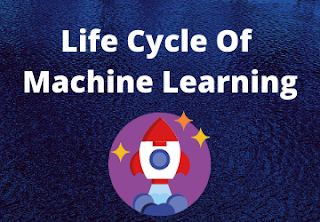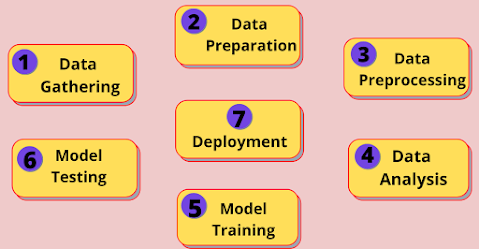Hello and welcome to the world of machine learning. In this article, I will take you through the complete journey of developing a machine learning model and how it works. Before diving into algorithms, it's important to understand the process, how does the model work.
Machine learning has given a computer system the ability to learn automatically without being supervised explicitly. So how does it work? Let's understand the life cycle of machine learning.
Table Of Contents
- Overview on Machine Learning
- Seven Major Steps of Machine Learning Life Cycle
- Data Collection
- Data preparation
- Data preprocessing
- Data analysis
- Train Model
- Test Model
- Deployment
- Conclusion
Brief Introduction to Machine Learning Lifecycle
The machine learning life cycle is a step-by-step cyclic process to build an efficient machine learning model. The purpose of performing all the steps is to find a very good solution to a particular problem.
The most important before implementation is to understand the problem statement that you are aiming to solve and the desire what you want from this. Therefore, before starting the life cycle it's most important to understand the problem statement.
The machine learning life cycle involves seven major steps:
1. Gathering Data
Machine learning is a field that completely relies on data so training the model data is required. So the most important step to building a machine learning model is to have the right data in the right quantity and then the process begins.
In this step, we need to collect the data from convenient resources. As there are various resources to get data such as files, databases, online web repositories(internet), mobile devices. or by web scrapping. The quantity and quality of data determine the efficiency of output. As per data, the model will be able to understand the hidden patterns very nicely so, more will be data, more will be accuracy.
By performing this step we get a coherent set of data known as a dataset.
2. Data Preparation
After the collection of data, we need to prepare it for further analysis. In this step, we put the data in a suitable place and try to understand the basic nature of the data.
Basic data exploration tasks are performed under this step where we understand the change factors to be comfortable working with data in further steps. We need to understand various characteristics, formats, and quality of data to better evaluate our results. In this, we find co-relations and general trends on data based on some statistical measures.
3. Data Preprocessing
The data preprocessing step is one of the crucial steps in any machine learning project. The step includes many sub-steps such as data cleaning, removing duplicates in data.
In simple words, data preprocessing can be defined as a process of cleaning and converting raw data into a usable format.
Data cleaning and removing inconsistency in data deal with the quality issue of data which is necessary to handle before moving forward.
The data which you have collected or got don't need to be neat and clean and of use. In a real-world application, the data contain the following inconsistencies-
- missing values
- duplicate values
- noise(It can be in many forms like different data types of different columns)
- i.e: there is a date column whose data type is an object(string)
4. Data Analysis
It is also an important step that you must perform before training the model. Most of the time this step is done under the data preprocessing only where you perform various feature engineering tasks and apply different techniques for the following reasons:
- encoding categorical variables
- outlier detection and handling
- normalizing and feature scaling
- feature transformation
The main aim of the step is to analyze the data using various techniques from different angles as well as visualize the results to better understand the hypothesis formed and solved by data. It all starts with the determination of the type of problem where we select the type of problem, whether it is supervised(Regression or classification), unsupervised(clustering or association), etc.
5. Model Training
Now, it's time to train the model. In this step, the model is trained based on various algorithms to improve the accuracy or performance and to obtain the desired outcome.
If train and test datasets are separately provided then it's excellent. Otherwise, we separate the dataset into training and testing sets and train the model based on the training dataset. This step is required so that model can understand the patterns, rules, and features.
6. Model Testing
Once, the model has been trained, then it's time to test the model to know how well is our model performance. In this step, we check whether our model is performing well or it's trying to learn any kind of noise.
Model testing determines the percentage accuracy of the model which is required. If it's not performing well then we try to improve it by using various measures like hyperparameter tuning, cross-validation, or by trying different algorithms.
7. Deployment
The last step of the machine learning life cycle is the deployment of a machine learning model to make it useful for the end-user.
solving any real-world problem only makes sense when you make it useful for the end-user. so if your machine learning model is giving approximate or accurate results with acceptable speed then it is been deployed at any public cloud. Deployment is similar to making a final report of the project.
CONCLUSION
Now, I hope you all are cleared with the complete process to solve the machine learning problem. Understanding the life cycle of any problem before solving is very much necessary. if you find any kind of doubts then you can use the comment box below, I will definitely solve your queries. Now, we will be moving forward and enter into practical machine learning with supervised machine learning and explore each algorithm with regression and classification analysis with complete mathematical intuition behind each algorithm.
keep learning, and enjoy your data science journey.



Each step is very nicely explained. Please post the next article of ML fast.
ReplyDelete